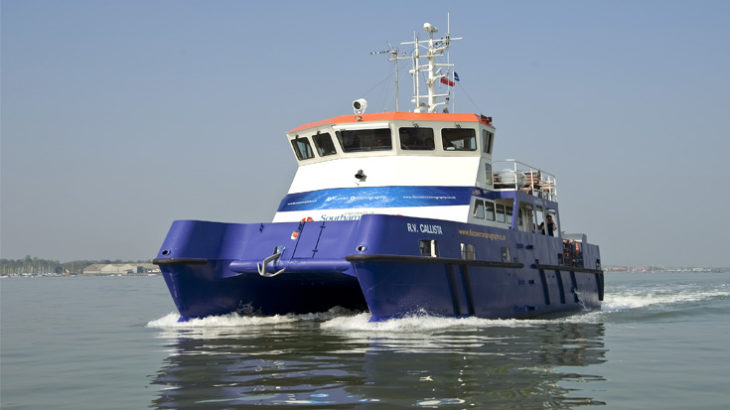Spotlight On: Callista

Each month we post a new edition to the SES ‘Spotlight On…’ series, showcasing equipment at our institutions, providing information and case studies for interested researchers/industries, and promoting better use of already available equipment.
Callista is a purpose built Research Vessel offering a unique capability for operations along the south coast for teaching and research as well as a platform for marine enterprise and industry. She is also used in the Discover Oceanography outreach programme which offers the opportunity to experience a hands-on introduction to marine science for groups of all ages.
She is is a 20m catamaran equipped with a 4 tonne A-frame, knuckle boom crane and side davit. She has a hull mounted Acoustic Doppler Current Profiler and dedicated CTD and bottle rosette system combining multiple other sensors.
“Callista was designed from the outset as a purpose built research vessel adapted for teaching. It means that not only does it have the capacity often only seen in larger vessels to undertake marine surveys, it is also configured to allow easy teaching of classes from 1 to 32 on board. The multiple screens, which can be configured to display anything from the on-board microscope to the depth profile of temperature and salinity from the ship’s “CTD” system, enable things to be explained to large groups. But successful research and teaching it is not just about the vessel itself. Callista is crewed by an experienced team, including a graduates of marine biology, oceanography and geology, who have a good in-depth understanding of the science requirements and the unique needs of a safe teaching environment.”
Dr Simon Boxall, University of Southampton
Name of Equipment
R.V. Callista
Any SLAs or standards (eg ISO, ..) associated with the facility:
ISO 14001
MCA Cat 2 Workboat
UK Class IV Passenger Vessel
Do you have to visit onsite?
Yes
Do you give preference to a particular type of researcher? E.g. Based on institution, field of research.
No. Bookings are taken on a first come, first served basis.
Current Research:
The vessel has been used as a floating platform for a huge amount of research over the last 12 years. From ocean chemistry to sea bird surveys and a lot of things in-between. Visit the Maritime Journal website for case studies.
A current example of recent research can be found here.
Where is it located?
University of Southampton Waterfront Campus, National Oceanography Centre Southampton (Empress Dock).
Who has access?
Callista is primarily a teaching vessel for undergraduate and postgraduate students studying at the University. However, the vessel is available for hire and many other Universities and colleges sail regularly. Over the years the vessel has been used for a huge variety of activities, ranging from filming for the Discovery Channel to deploying whale carcasses off the coast of Plymouth for whale-fall experiments.
She is available for commercial hire, inclusive of highly skilled technicians/crew. Recent successful work has included ASV trials with the NOCS, AAIB equipment trials, Nortek UK equipment trials and customer demonstrations and SIFCA training exercises.
The Discover Oceanography Outreach program can be booked by individuals, school or interest groups. Participants are taken out on the water for a 3 hour hands on introduction to marine science.
Are there any costs or associated fees?
Hire rates are available for 1/2 day, 8 hour day, 12 hour day and longer periods. The majority of bookings require an estimate to be prepared as no two bookings are ever the same! Details are on the www.southamptonboats.co.uk web site.
Can it be bought as a service with access to a team of experts?
Wherever possible, a bespoke package is offered that can include access to experts in a particular field if requested.
Links:
Contact:

Mr Gary Fisher
Deputy Technical Superintendent, Ocean and Earth Science, University of Southampton

